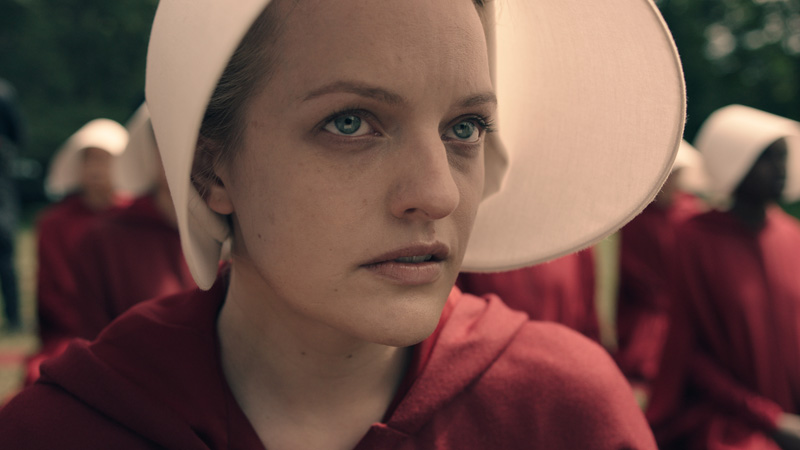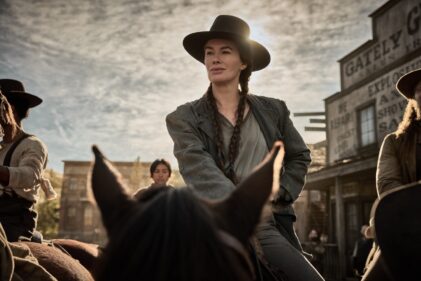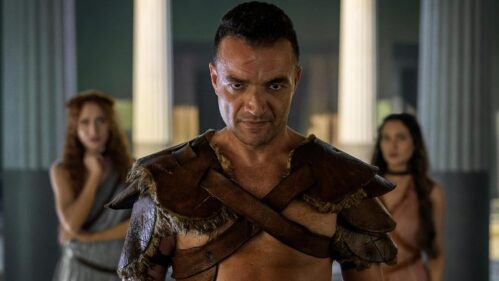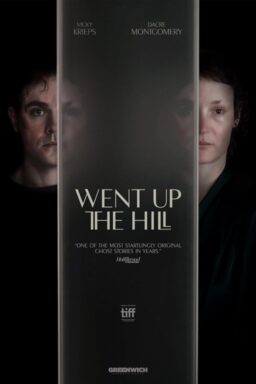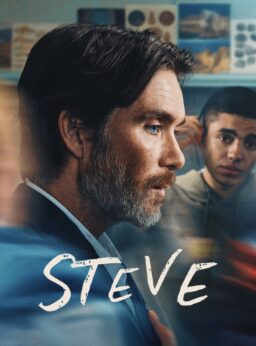When they started production a couple years ago, Hulu never could have guessed how relevant their adaptation of Margaret Atwood’s “The Handmaid’s Tale” would feel when it premiered in April 2017. There’s a scene in the third episode (the first trio premiere on Hulu tomorrow, April 26, and then they premiere at a rate of one a week), in which a group of protesters are marching for rights that are being increasingly taken away from women. It looks a lot like the women’s rights marches that took place all over the country in the last few months. This one ends in gunfire.
“The Handmaid’s Tale” asks how far we are away from true horror. What will we do to stop it and how we will behave when we can’t? This excellent drama makes a convincing case that humanity will allow the destruction of basic civil rights if it only benefits the male upper class, and happens in such a way that refusal seems impossible. And then it becomes the norm. “This may not seem ordinary to you right now, but after a time it will,” says Aunt Lydia (Ann Dowd). Again, it’s hard not to think of a real world so currently in a state of disruption. Will it too become ordinary?
Most of “The Handmaid’s Tale” takes place in the broken future, but we see glimpses through flashbacks of our protagonist as to how we got here. Conflicts around the world became more violent and devastating; governments were overthrown; most crucially, birthrates plummeted. Most women couldn’t have children, and even those who could only gave birth successfully one out of five times. As society crumbled, and a new one was formed called Gilead, the ruling class of men used their power, turning the remaining fertile women into handmaids. They are “two-legged wombs” for their Commanders, forced into a monthly sexual encounter on their most fertile day in an effort to give their owners more heirs. Everything becomes ritual, and no one can be trusted. The Handmaids have little to no power, existing in a rare space between property and pedestal. They are needed—there is no future without them—so they are treated better than most woman in this vision of the future, but they are also mentally and physically abused in almost unimaginable ways.

Our eyes into this world are the fascinating ones of Elisabeth Moss as Offred. Framed by a unique bonnet, so much of the first two episodes of “The Handmaid’s Tale” takes place in those eyes, and Moss gives one of the best performances of the year in any drama. She is the anchor of the show. Whenever it feels like it’s getting a bit too pretentious—the music and visual language often telegraph that the creators know this is “Very Important TV” in the early episodes—Moss brings it back down to something relatable. And then the POV expands a bit in the stellar third episode and doesn’t look back. Joseph Fiennes plays Offred’s Commander; Yvonne Strahovski is his wife; Samira Wiley is Moira, a close friend of Offred’s in the days before society’s collapse; Alexis Bledel is a mysterious fellow handmaid; and Max Minghella plays a driver who seems to be particularly interested in Offred.
“The Handmaid’s Tale” is a masterful example of how a show achieves cumulative power through details. The show’s concept, of course, overwhelms much of the first episode, but director Reed Morano (“Meadowland”), finds unique ways to reveal other details about this world gradually. Much of the writing about “The Handmaid’s Tale” has focused on the feminist message at its core and the parallels to challenges to women’s rights in 2017, but there are also fascinating undercurrents that Morano and the writers allow to merely enrich the background, such as how paranoia changes behavior, how believing in a vengeful God changes authority (you’re just doing his work), and how fear so often drives action. The third episode offers the best detail and arguably the most current commentary with the concept of how ingrained “women as property” can be not just in this vision of the future but today. Before the collapse, women were uniformly fired and their bank accounts closed. What’s the quickest way to dehumanize someone? Take away their ability to rightfully own anything. Then they can be owned.

“The Handmaid’s Tale” is visually striking—no surprise given Morano shot “Frozen River” and “Kill Your Darlings,” among others—but it’s a show more concerned with faces than a sci-fi vision of the future. And what faces. Elisabeth Moss should have won a couple Emmys for “Mad Men” and one for “Top of the Lake.” That she didn’t get any only further proves the silliness of those awards, although this could develop into her best work to date and finally get her that trophy. She is so genuinely in the moment, selling the big picture of this show along with the small picture story of her character’s life. The whole cast is great—Dowd and Bledel are stand-outs early in the supporting cast—but this is Moss’ show. And Morano’s. And, of course, Atwood’s.
Hulu has been looking for a show like this for a long time. They’ve had some minor critical success with shows like “The Path” and “11.22.63,” but this is the program that takes their status in the medium to another level. To say it’s their best program would be an understatement. It is ambitious, rich, complex, beautifully made television. It may take a couple episodes to really show you what it has to offer, but then you won’t be able to turn away.

